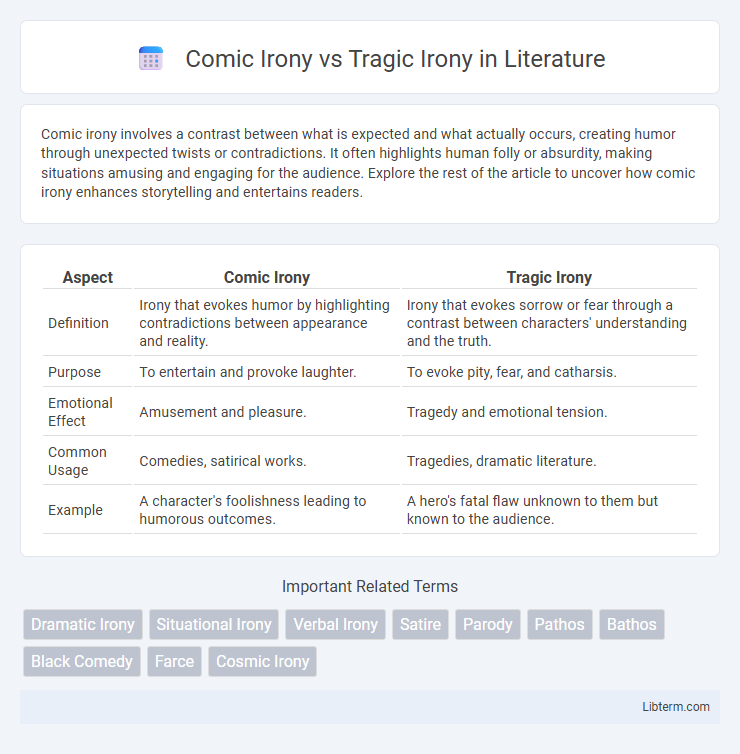Comic irony involves a contrast between what is expected and what actually occurs, creating humor through unexpected twists or contradictions. It often highlights human folly or absurdity, making situations amusing and engaging for the audience. Explore the rest of the article to uncover how comic irony enhances storytelling and entertains readers.
Table of Comparison
| Aspect | Comic Irony | Tragic Irony |
|---|---|---|
| Definition | Irony that evokes humor by highlighting contradictions between appearance and reality. | Irony that evokes sorrow or fear through a contrast between characters' understanding and the truth. |
| Purpose | To entertain and provoke laughter. | To evoke pity, fear, and catharsis. |
| Emotional Effect | Amusement and pleasure. | Tragedy and emotional tension. |
| Common Usage | Comedies, satirical works. | Tragedies, dramatic literature. |
| Example | A character's foolishness leading to humorous outcomes. | A hero's fatal flaw unknown to them but known to the audience. |
Introduction to Irony in Literature
Irony in literature involves a contrast between expectations and reality, creating layers of meaning that enhance storytelling. Comic irony typically produces humor by highlighting absurdity or contradictions in characters' actions or situations. In contrast, tragic irony evokes a sense of sorrow or foreboding, often through a character's ignorance of their fate while the audience possesses critical insight.
Defining Comic Irony
Comic irony is a literary device where the audience perceives a humorous discrepancy between a character's understanding and the reality of a situation, often highlighting human folly or absurdity. It relies on incongruities, exaggeration, and wit to create laughter and relieve tension, contrasting with tragic irony that evokes pity or fear through inevitable misfortune. Examples include Shakespeare's use of mistaken identity in "A Midsummer Night's Dream" to generate humor through comic irony.
Understanding Tragic Irony
Tragic irony occurs when the audience possesses knowledge that the characters lack, intensifying the emotional impact as characters unknowingly make decisions leading to their downfall. This type of irony highlights the inevitable fate and human limitations, often evoking feelings of pity and fear. Understanding tragic irony is essential in analyzing classic tragedies where it underscores the contrast between appearance and reality, deepening the narrative tension.
Key Differences: Comic vs Tragic Irony
Comic irony involves situations where the outcome is humorously contrary to expectations, often highlighting human folly and eliciting laughter, while tragic irony presents a contrast between appearance and reality that leads to suffering or disaster, evoking pity or fear. In comic irony, characters' misunderstandings or mistakes typically result in amusing consequences, whereas tragic irony often involves the audience's awareness of impending doom unknown to the characters. The key difference lies in the emotional response: comic irony generates amusement through lighthearted incongruities, whereas tragic irony produces a somber mood through inevitable, often fatal revelations.
Purposes and Effects in Storytelling
Comic irony serves to entertain and provoke laughter by highlighting absurdities and incongruities in characters or situations, often leading to a lighthearted resolution that reinforces social norms or critiques human folly. Tragic irony intensifies emotional impact by exposing a character's ignorance of their doomed fate, evoking feelings of pity and fear that underscore the themes of human vulnerability and inevitable suffering. Both forms of irony deepen narrative complexity, with comic irony fostering empathy through humor and tragic irony prompting profound reflection on fate and moral consequences.
Famous Examples of Comic Irony
Comic irony often manifests in literature and theater where characters' actions lead to humorous misunderstandings, such as in Shakespeare's "Much Ado About Nothing," where mistaken identities create comedic situations. Another famous example is Oscar Wilde's "The Importance of Being Earnest," where witty dialogue and absurd scenarios highlight social satire through ironic contrasts between characters' intentions and outcomes. These instances exemplify how comic irony evokes laughter by exposing the gap between appearance and reality in a lighthearted manner.
Notable Instances of Tragic Irony
Notable instances of tragic irony often appear in classic literature where characters' fates are sealed by futile actions and misunderstood intentions, such as Oedipus unknowingly fulfilling the prophecy of patricide and incest in Sophocles' "Oedipus Rex." Shakespeare's "Romeo and Juliet" presents tragic irony through the audience's awareness of Juliet's feigned death, contrasting the characters' ignorance, which culminates in the lovers' actual demise. These examples highlight the profound emotional impact and thematic depth achieved through tragic irony, emphasizing fate, misunderstanding, and inevitable tragedy.
Impact on Readers and Audiences
Comic irony elicits amusement and relief by highlighting human folly, allowing readers and audiences to engage with characters' mistakes in a lighthearted manner that fosters empathy and entertainment. Tragic irony intensifies emotional impact through the audience's awareness of impending disaster unknown to characters, evoking feelings of suspense, sorrow, and catharsis. Both forms deepen narrative complexity but produce contrasting psychological effects, shaping audience engagement and thematic resonance.
Using Irony to Develop Characters
Comic irony highlights characters' flaws through humorous contradictions between expectations and reality, revealing their quirks and enhancing relatability. Tragic irony exposes characters' misunderstandings or fate-driven errors, deepening the audience's insight into their vulnerabilities and the gravity of their situations. Both forms of irony serve as powerful tools to develop character complexity by illustrating internal conflicts and prompting emotional engagement.
Conclusion: Choosing the Right Irony for Your Narrative
Choosing the right irony for your narrative hinges on the desired emotional impact and thematic depth: comic irony often elicits humor and lightheartedness by highlighting human folly, while tragic irony evokes empathy and tension through inevitable misfortune. Effective use of comic irony can make characters relatable and stories memorable by blending wit with situational contrast. In contrast, tragic irony intensifies dramatic irony by emphasizing the gap between characters' understanding and reality, thus deepening the audience's emotional engagement and reinforcing the narrative's moral or thematic message.
Comic Irony Infographic

 libterm.com
libterm.com